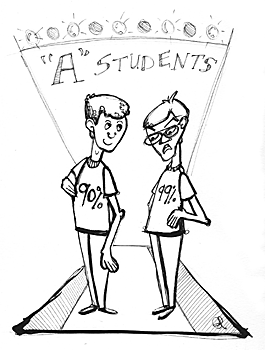
Illustration by Patricia Tompkins
|
|
By Ryan Johnson
Arizona Daily Wildcat
Tuesday, October 4, 2005
Print this
Figuring out what to study for during finals always seems like something of a game:
Calculate what percent you have in each class and what grade you need on the final, anticipate how hard the final exams in each of the classes will be, and then decide where limited study time can most efficiently be allocated.
If your grade in a given class is 85 percent or above 95 percent, you don't need to worry about it as much as other classes. After all, with 85 percent before the final, the chances of jumping to 90 percent or dropping below 80 percent are somewhat slim. Much better to study for the class you have 90 percent in.
Although the idea of academics is to learn as much as possible so as to prepare for future careers, one poorly thought-out policy has led students to shoot for just barely above an arbitrary percentage.
This perverse fight to the thresholds is all an unfortunate consequence of the UA having only whole letter grades, with no plusses or minuses. It discourages students from getting higher than 90 percent, effectively saying that getting 99 percent was 9 percent of wasted effort. It says that the difference between 100 percent and 80 percent is the same as the difference between 89 percent and 90 percent.
Yet for various reasons, any proposal to change to a plus/minus system is bound to face considerable criticism from students.
Nowadays, it seems one can take the pulse of a university based on the response an issue garners on www.facebook.com. And, indeed, Arizona State University has a thriving group complaining against the plus/minus system. The group description: "For everyone that thinks it's ridiculous that getting 92 percent in every class doesn't get you a 4.0."
But someone with a 92 percent shouldn't get the same grade as someone who gets 99 percent, and graduate schools should know which students really learned the material and which students scraped by with 90 percent in every class. Giving students the top grade for inferior work does a disservice to employers as much as it does for students.
The result of a whole-grade system is that there are too many students around the top end of the grade range. With hundreds of students graduating with perfect or near-perfect grade point averages, employers and graduate schools can't rely on grades to tell them which students are truly the best.
Those against the plus/minus system say that it will force students to spend more time studying for class, which will decrease the amount of time students spend on extracurriculars.
This may be true in some cases, but students trying to distinguish themselves because they can't do so based on grades are blowing the importance of extracurriculars out of proportion. If it means a student can be involved in only three clubs instead of six, it's not the end of the world.
As far as those who say that a plus/minus system would be more difficult for people who have to work, their argument misunderstands the purpose of grades. Grades have nothing to do with fairness, but rather are used to show how much material was learned.
Opposition to plus/minus grading systems is really about students that are afraid they'll have to work harder. In the end, it helps everyone by providing a more informative grading system.
Exactly how, then, should the plus/minus system be implemented?
At ASU, the policy was implemented for everyone at the same time starting in fall 2004. And though an A+ is worth 4.33 grade points when computing the GPA, students' final graduating GPA is capped at 4.0. That sounds like a good idea.
In the end, even a plus/minus system may not achieve the more important goal: reducing grade inflation. But by eliminating the "threshold effect," it will make all students better off. Students should want this to end. They should want a more direct link between performance and evaluation.
Any change of this nature needs to be done by the faculty senate. Professors should clearly want a plus/minus system; it removes uncertainty from grades and allows them to distinguish their top students.
In 2004, Vice Provost Jerry Hogle said that that UA would first need two years to change the computer systems to be able to handle a plus/minus system, but it also must pass a resolution to make it happen.
For the good of students and professors, then, the Faculty Senate owes it to everyone to make grades plus/minus.
Ryan Johnson is a senior majoring in economics and international studies. He can be reached at letters@wildcat.arizona.edu.
